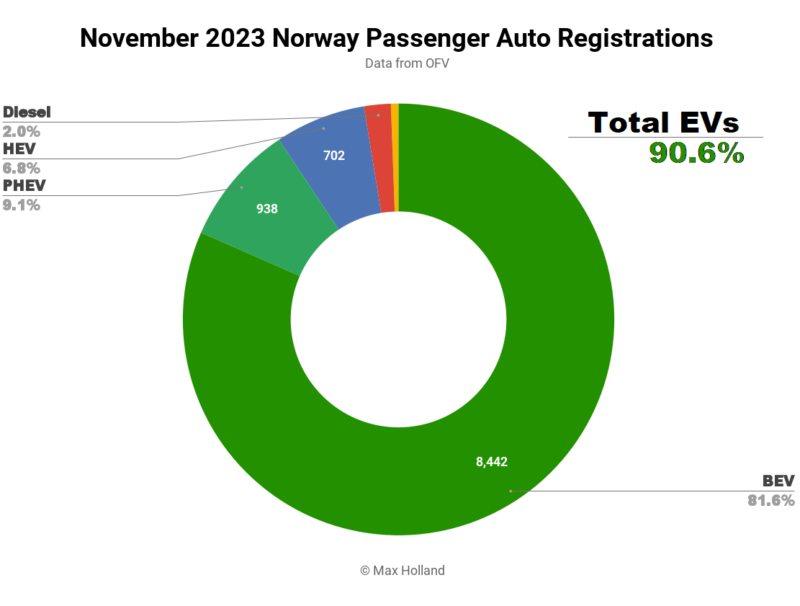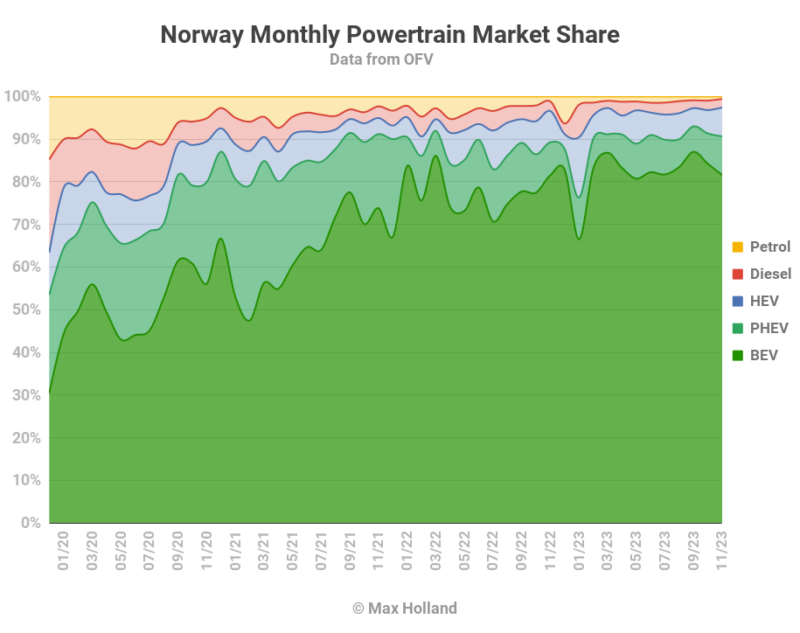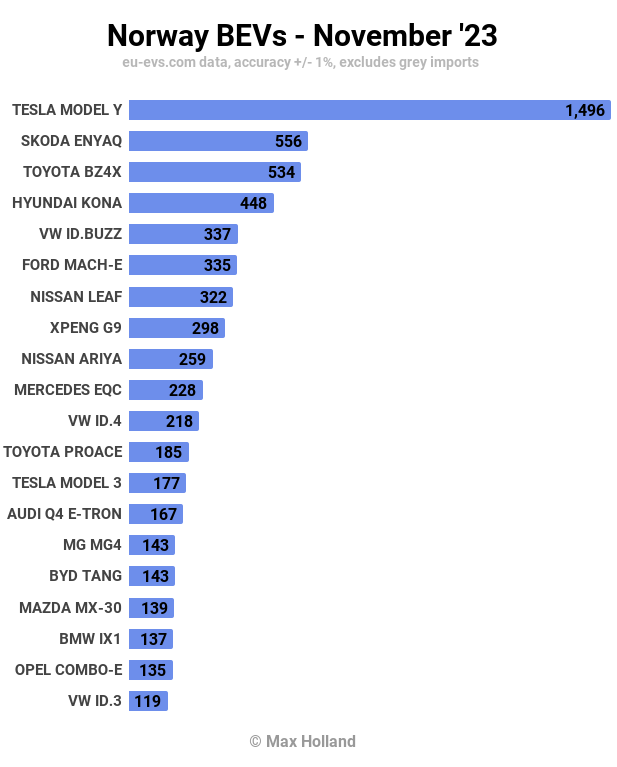Sign up for daily news updates from CleanTechnica on email. Or follow us on Google News!
November saw plugin EVs take 90.6% share in Norway, up from 89.3% year on year. Petrol-only vehicles saw record low share of 0.6% of the auto market. Overall auto volume was 10,348 units, somewhat below seasonal norms. The Tesla Model Y was again September’s bestseller, and several new models debuted.

November’s market saw combined EVs take 90.6% share, with BEVs (full battery electrics) contributing a record 81.6%, and PHEVs (plugin hybrids) at 9.1%. These compare YoY with figures of 89.3%, with 81.6% BEVs, and 7.7% PHEVs.
We can see that BEV share is flat YoY, with PHEVs slightly up. The November 2022 BEV baseline was elevated somewhat by pull-forward sales ahead of the January 1st rule change, which explains the flat YoY share growth.
Other powertrains were affected by the January rule change also, such that the pull-forward in November 2022 increased sales volumes across the board. Thus November 2023’s YoY volume comparisons look paltry for every powertrain, including plugins, with BEVs down 47% and PHEVs down 37%. However, the weakest volumes were for combustion-only powertrains…
Combined petrol-only and diesel-only vehicles sold just 266 units in November. This amounted to 2.6% share of the market, a new record low. Petrol-only was especially hard hit at 59 units, and just 0.6% market share.
In terms of year-to-date cumulative share, BEVs are still growing, though are certainly now at the top of the technology adoption S-curve, up YoY from 78.3% to 83.5%. The figure for November 2021 was a steeper 64.2%.

Best Sellers
With Tesla resuming volume shipping in November, the Model Y was again by far the best selling vehicle, at 1,496 units. The Skoda Enyaq, and Toyota BZ4X, came in second and third.

The Tesla is so popular in Norway that it almost outsold the next 3 models combined, even in a not-peak-volume month.
There was just one notable performance in the top 20 — the new Xpeng G9 ramped up monthly volume to 298 units (from 78 in October, 12 in September), and won 8th spot in the chart.
As I noted in last month’s report, the G9 has a competitor in the new Nio EL6, and this model also stepped up deliveries in November, but at a much shallower rate, to 16 units (from its debut 9 units in October), and far outside the top 20.
There were three notable newcomers to Norway in November:
First the Volkswagen ID.7, which came in hot, with 73 debut sales. For more on the ID.7, see November’s Sweden report. Next up, the Kia EV9 also made its Norwegian debut in November, with 32 initial units. Given Norway’s great proclivity for SUVs over sedans, this is arguably a more important debut than the ID.7, and will sell many more over time.
Finally, a modest Norwegian debut for the Ford F150 Lightning pickup truck, with 4 units. This vehicle, like most pickup trucks popular in the US market, is generally too large (5,911 mm length) for the European human environment.
Farmers, other rural workers, and construction contractors in Europe tend to opt for smaller pickups like the Nissan Navara (5,120 mm), or Mitsubishi L200 (5,115 mm), or something similar, which are still very large vehicles in Europe.
Unfortunately, few of these kinds of smaller pickups — often from Japanese brands — are offered in BEV versions so far. One exception is the Maxus T90 pickup, (priced from 584,900 krone, €49,750) but this is unfortunately limited to 2 wheel drive for now (not the best fit for off-highway work in Norwegian winters), though an AWD variant is coming. Currently the T90 is selling an average of just 10 units per month.
So, for now, the Ford F150 is at least one more option for those who have enough space to manoeuvre it. It is currently priced at 1,183,000 krone (€100,606), which is another reason why it won’t be a volume seller.
Let’s now look at the longer term rankings:

Here, the Tesla Model Y’s strong lead is clear, outselling the next 3 BEVs combined.
The Toyota BZ4X has climbed since the previous period (June to August), now up to 3rd, from 6th. Likewise, the Hyundai Kona has climbed strongly, thanks to its recent refresh, now up to 4th, from 10th. The Nissan Leaf is another climber, up to 8th, from 20th. As a side note, Mercedes seems to be having a late clearance for its “old” EQC model (on sale from 2019), which has already ceased sales in neighbouring Sweden. It was way up to 13th position, from 47th previously.
Thanks to a remarkably strong debut, the Xpeng G9 is already in the top 20, in 17th spot, a very impressive early start.
Conversely, some models have dropped off. The Volkswagen ID.4 has fallen to 9th, from 2nd previously, and — at 724 units — just around a quarter of its prior volume. The Audi Q8 e-tron also fell dramatically, from 9th to 31st. The Volvo XC40 fell from 11th to 48th, though this is likely to reverse now that the newly refreshed and improved model is starting to show up.
The Kia EV6 also fell off, from 12th to 36th, likely due to uneven international shipping allocations. Especially with a smaller market like Norway, irregular supply allocation decisions for certain models can cause large changes in ranking, even over a 3-month window, and don’t necessarily reflect significant demand changes.
In case you missed it, last month I did an updated deep dive into the progress of Norway’s vehicle fleet in the transition to electric, and the correlated reduction in fossil fuel demand. Please take a look there if that is of interest.
Outlook
Even if we exclude the outlying 2022 Q4, Norway’s auto market seasonal volume is down from the already-modest 2021 and 2020. We saw last month that the OFV is currently estimating a 25% volume drop in full year 2023 compared to 2022. Recall that they recently stated that the economic conditions were primarily to blame, saying that “increased interest rates and strong inflation sting strongly for many.”
The broader economy’s performance in Q3 was negative 1.9% YoY, the worst performance since peak-pandemic in mid 2020. Interest rates remain high at 4.25%. Headline inflation had cooled in September, but is now rising again, currently at 4%.
In these conditions, the auto market is not expected to get back on track until the economy turns positive once more. However, for those reduced number of buyers who are still able to buy a new vehicle, plugins are still relatively more attractive than combustion vehicles. So whatever is happening with volumes, the market share of plugins will still slowly climb.
What do you think about Norway’s EV transition? Please jump in to the comment section and let us know.
Have a tip for CleanTechnica? Want to advertise? Want to suggest a guest for our CleanTech Talk podcast? Contact us here.
CleanTechnica Holiday Wish Book
Our Latest EVObsession Video
I don’t like paywalls. You don’t like paywalls. Who likes paywalls? Here at CleanTechnica, we implemented a limited paywall for a while, but it always felt wrong — and it was always tough to decide what we should put behind there. In theory, your most exclusive and best content goes behind a paywall. But then fewer people read it!! So, we’ve decided to completely nix paywalls here at CleanTechnica. But…
Thank you!
CleanTechnica uses affiliate links. See our policy here.





